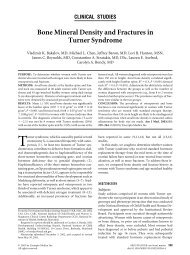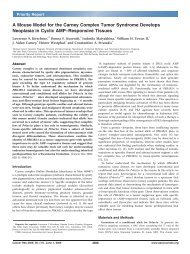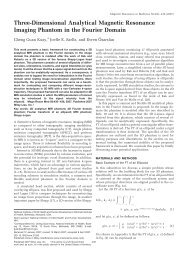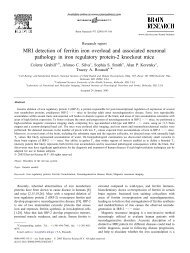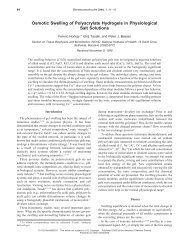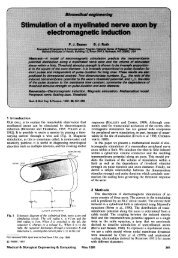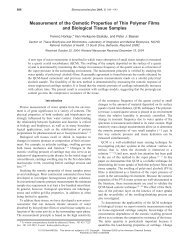Dysmenorrhea After Bilateral Tubal Ligation - Endometriosis ...
Dysmenorrhea After Bilateral Tubal Ligation - Endometriosis ...
Dysmenorrhea After Bilateral Tubal Ligation - Endometriosis ...
You also want an ePaper? Increase the reach of your titles
YUMPU automatically turns print PDFs into web optimized ePapers that Google loves.
placental and neonatal blood cultures that this patient<br />
had an intrauterine infection with Shigella sp. To our<br />
knowledge, this is the first case to better document<br />
Shigella infection and its association with chorioamnionitis<br />
leading to preterm PROM and preterm delivery, as<br />
well as the first case of congenital shigellosis.<br />
Armor et al 4 reported a case of Shigella chorioamnionitis<br />
in a postterm patient resulting in neonatal Shigella<br />
bacteremia and pneumonia. Ruderman et al 5 reported a<br />
preterm delivery at 30 weeks in which postpartum maternal<br />
stool culture revealed S sonnei, whereas an asymptomatic<br />
neonate had S sonnei–positive blood cultures.<br />
However, in this report, placental, amniotic fluid, or<br />
vaginal maternal cultures were not described. Therefore,<br />
causal association for the preterm delivery in their case<br />
report can only be inferred. In fact, the neonatal bacteremia<br />
may have been secondary to maternal transmission<br />
in the postnatal period.<br />
Most intrauterine pathogens in pregnancy are believed<br />
to ascend the vaginal vault and cervix and cause<br />
infection as they travel along the chorioamniotic membranes.<br />
In our patient, both maternal and fetal membrane<br />
cultures were positive for Shigella at time of delivery.<br />
The upper genital tract cultures were positive for<br />
Shigella, whereas the lower vaginal tract cultures revealed<br />
normal vaginal flora. We speculate that in this case<br />
intrauterine infection was not attributable to vaginal<br />
colonization, but to maternal hematogenous spread. Shigella<br />
is a highly virulent enteroinvasive organism, which<br />
has been reported to result in bacteremia/sepsis.<br />
Interestingly, this preterm fetus of 26 0 ⁄7 weeks passed<br />
meconium before delivery. Meconium is seldom passed<br />
before 34 weeks. Its presence is often believed to reflect<br />
gastrointestinal maturity in late gestation, as the immaturity<br />
of intrinsic and extrinsic innervation of the bowel<br />
may impair the ability of the premature fetus to pass<br />
meconium. Furthermore, this fetus showed little hypoxic<br />
insult as revealed by a reassuring fetal heart tracing and<br />
cord gases at time of delivery. We must, therefore,<br />
question the reason for passage of meconium in an<br />
“unstressed” preterm fetus. Perhaps the passage of meconium<br />
is related to the fetal swallowing of Shigella-infected<br />
amniotic fluid resulting in fetal shigellosis. The Shigella<br />
toxin damages the mucosal layer of the colon, thus<br />
limiting absorption of fluids and electrolytes and resulting<br />
in a liquid stool. Positive fetal stool cultures and<br />
negative fetal blood cultures at delivery indicate that the<br />
infection may have been localized to the fetal/neonatal<br />
gastrointestinal tract.<br />
As preterm PROM and its associated preterm delivery<br />
have significant morbidity and mortality, it is prudent to<br />
consider Shigella infection in symptomatic patients. Clinicians<br />
should consider treatment of symptomatic patients<br />
(ie, bloody diarrhea) empirically, particularly those patients<br />
with risk factors for Shigella infection. Neonatal testing is<br />
indicated if maternal disease is suspected before delivery.<br />
REFERENCES<br />
1. Centers for Disease Control and Prevention. Shigellosis: General<br />
information. Available at: http://www.cdc.gov/ncidod/<br />
dbmd/diseaseinfo/shigellosis_g.htm. Accessed 2002 Sep 18.<br />
2. American College of Obstetricians and Gynecologists. Premature<br />
rupture of membranes. ACOG practice bulletin no.<br />
1. Washington, DC: American College of Obstetricians and<br />
Gynecologists, 1998.<br />
3. Levinson WE, Jawetz E. Medical microbiology and immunology.<br />
4th ed. Norwalk, CT: Appleton & Lange, 1996.<br />
4. Armor SA, Law QO, Monif GR. Periparturitional shigellosis.<br />
Nebraska Med J 1990;75:239–41.<br />
5. Ruderman JW, Stoller KP, Pomerance JJ. Blood stream<br />
invasion with Shigella sonnei in an asymptomatic newborn<br />
infant. Pediatr Infect Dis 1986;5:379–80.<br />
Received October 23, 2001. Received in revised form January 11, 2002.<br />
Accepted January 31, 2002.<br />
<strong>Dysmenorrhea</strong> <strong>After</strong> <strong>Bilateral</strong><br />
<strong>Tubal</strong> <strong>Ligation</strong>: A Case of<br />
Retrograde Menstruation<br />
Kelly Morrissey, Nadine Idriss,<br />
Lynnette Nieman, MD, Craig Winkel, MD, and<br />
Pamela Stratton, MD<br />
Pediatric and Reproductive Endocrinology Branch, National Institute of Child<br />
Health and Human Development, Bethesda, Maryland; and Georgetown University<br />
Medical Center, Washington, District of Columbia<br />
BACKGROUND: <strong>Endometriosis</strong>, arising de novo, is believed<br />
to be uncommon in women who have undergone bilateral<br />
tubal ligation because the occluded tube prevents outflow<br />
of blood and menses.<br />
CASE: A woman 10-year status-post bilateral tubal ligation<br />
suffered from dysmenorrhea and menorrhagia that began<br />
within 1 year after sterilization. At the time of bilateral<br />
Address reprint requests to: Pamela Stratton, MD, National Institute of<br />
Child Health & Human Development, Pediatric and Reproductive<br />
Endocrinology Branch, Chief, Gynecology Consult Service, 10 Center<br />
Drive, MSC 1583, Building 10, Room 9D42, Bethesda, MD 20892-<br />
1583; E-mail: ps79c@nih.gov.<br />
VOL. 100, NO. 5, PART 2, NOVEMBER 2002 0029-7844/02/$22.00<br />
© 2002 by The American College of Obstetricians and Gynecologists. Published by Elsevier Science Inc. PII S0029-7844(02)01991-9<br />
1065
tubal ligation, no endometriosis was observed. A recent<br />
magnetic resonance imaging scan showed no pelvic abnormalities,<br />
and the patient underwent a diagnostic laparoscopy<br />
in anticipation of finding endometriosis, yet none was<br />
found. At laparoscopy performed on day 3 of her menstrual<br />
cycle, the proximal segments of her occluded fallopian<br />
tubes were dilated with blood. As this was the only<br />
abnormality found, we postulated that her dysmenorrhea<br />
might be related to the dilated proximal tubal stumps. We<br />
evacuated the bloody fluid and occluded the proximal tube<br />
at the cornua with Filshie clips. One year after surgery, the<br />
patient remains asymptomatic.<br />
CONCLUSION: This case is unique because bilateral tubal<br />
ligation combined with retrograde menstrual flow appears<br />
to have caused dysmenorrhea. Women who have undergone<br />
tubal ligation and who have dysmenorrhea may<br />
benefit from a diagnostic laparoscopy during menstruation<br />
to evaluate the possibility of retrograde menstruation dilating<br />
the proximal tubal stumps. (Obstet Gynecol 2002;<br />
100:1065–7. © 2002 by The American College of Obstetricians<br />
and Gynecologists.)<br />
<strong>Bilateral</strong> tubal ligation is one of the most prevalent and<br />
effective contraceptive methods, with a 0.4% pregnancy<br />
rate after 1 year and a cumulative failure rate of 1.85%<br />
after 10 years. 1–3<br />
<strong>Endometriosis</strong>, a disease in which endometrial glands<br />
and stroma grow outside the uterus, may develop after<br />
retrograde menstruation and seeding of the peritoneal<br />
cavity with endometrial cells. 4 The development of endometriosis<br />
is uncommon in women who have undergone<br />
bilateral tubal ligation because the occluded tubes<br />
do not allow the outflow of menstrual fluid into the<br />
peritoneal cavity. In the present case, we describe a<br />
woman who had dysmenorrhea after bilateral tubal ligation,<br />
presumably from proximal tubal segments dilated<br />
with blood as a result of retrograde menstruation.<br />
CASE<br />
A woman 10-year status-post bilateral tubal ligation presented<br />
with a 10-year history of worsening dysmenorrhea<br />
and menorrhagia. At the time of bilateral tubal<br />
ligation, no endometriosis or other pelvic pathology was<br />
noted. The patient tried taking oral contraceptive pills to<br />
alleviate the pain without relief. Pelvic examination was<br />
unremarkable. A recent pelvic magnetic resonance imaging<br />
scan was normal with a mildly prominent endometrial<br />
cavity, small follicles in the right ovary, and a 1.6-cm<br />
cyst in the left ovary. The cyst was believed to be a<br />
normal physiologic follicle. <strong>Endometriosis</strong> was suspected,<br />
and she enrolled in a study of the clinical management<br />
of endometriosis. At laparoscopy performed on<br />
day 3 of her menstrual cycle, there was no evidence of<br />
endometriosis. However, the proximal portions of both<br />
ligated fallopian tubes were dilated with menstrual<br />
blood. Bipolar cautery scissors were used to open the<br />
distal ends of the proximal tubal segments and drain the<br />
bloody fluid. Filshie clips were placed at the cornuas of<br />
the proximal portions of both tubes. The abdomen was<br />
suction lavaged, and the tubes were then recauterized.<br />
No postoperative complications occurred. During the<br />
year since surgery, she no longer has dysmenorrhea.<br />
COMMENT<br />
Women who have undergone tubal ligation are no more<br />
likely than other women to have menstrual abnormalities,<br />
5 and most patients experience no long-term complications<br />
after bilateral tubal ligation. Leaving a 2- to 3-cm<br />
stump minimizes the risk of fistula formation, allows for<br />
tubal reversal, and reduces postsurgical complications. 6<br />
However, in our patient, the proximal stumps filled<br />
with menstrual fluid during menstruation. Previous reports<br />
have suggested that retrograde menstruation occurs<br />
in 90% of all women, 7 although it is not generally<br />
associated with pain, presumably because the menses<br />
flow into the abdominal cavity rather than dilating the<br />
fallopian tube. In this case, because drainage of the fluid<br />
and occlusion of the cornual junctions improved pain<br />
immediately, we infer that tubal dilatation from the<br />
collection of blood was the cause of her severe menstrual<br />
pain. A previous study investigating the cause of pelvic<br />
pain in women who had tubal ligation followed later by<br />
endometrial ablation found that the proximal portions of<br />
one or both tubes were dilated in every case. 8<br />
These observations suggest that for women who complain<br />
of dysmenorrhea after bilateral tubal ligation, laparoscopy<br />
should be performed during menstruation to<br />
determine whether retrograde menstrual flow is causing<br />
dilatation of the proximal fallopian tubal segments. Had<br />
this operation not been performed during menstruation,<br />
dilatation of her occluded tubes may not have been<br />
discovered. Thus, women who have undergone tubal<br />
occlusion and who have dysmenorrhea may benefit<br />
from a diagnostic laparoscopy.<br />
REFERENCES<br />
1. Chi IC, Jones DB. Incidence, risk factors, and prevention of<br />
post sterilization regret in women: An updated international<br />
review from an epidemiological perspective. Obstet<br />
Gynecol Surv 1994;49:722–32.<br />
2. Peterson HB, Xia Z, Hughes JM, Wilcox LS, Tylor LR,<br />
Trussell J. The risk of pregnancy after tubal sterilization:<br />
Findings from the US Collaborative Review of Sterilization.<br />
Am J Obstet Gynecol 1996;174:1161–8.<br />
3. Trussel J, Hatcher RA, Cates W Jr, Stewart FH, Kost K.<br />
1066 Morrissey et al <strong>Dysmenorrhea</strong> <strong>After</strong> <strong>Bilateral</strong> <strong>Tubal</strong> <strong>Ligation</strong> OBSTETRICS & GYNECOLOGY
Contraceptive failure in the United States: An update. Stud<br />
Fam Plann 1990;21:51–4.<br />
4. Duleba AJ. Diagnosis of endometriosis. Obstet Gynecol<br />
Clin North Amer 1997;24:331–46.<br />
5. Peterson HB, Jeng G, Folger SG, Hillis SA, Marchbanks<br />
PA, Wilcox LS. The risk of menstrual abnormalities after<br />
tubal sterilization. N Engl J Med 2000;343:1724–6.<br />
6. Ryder RM, Vaughan MC. Laparoscopic tubal sterilization:<br />
Methods, effectiveness, and sequelae. Obstet Gynecol Clin<br />
1999;26:83–95.<br />
7. Halme J, Hammond M, Hulka J, Raj S, Talbert L. Retrograde<br />
menstruation in healthy women and in patients with<br />
endometriosis. Obstet Gynecol 1984;64:151–4.<br />
8. Townsend DE, McCausland V, McCausland A, Fields G,<br />
Kauffman K. Post-ablation-tubal sterilization syndrome.<br />
Obstet Gynecol 1993;82:422–4.<br />
Received October 31, 2001. Received in revised form January 17, 2002.<br />
Accepted February 7, 2002.<br />
Pain in the Foot: Calcaneal<br />
Metastasis as the Presenting<br />
Feature of Endometrial Cancer<br />
Tom P. Manolitsas, MD,<br />
Jeffrey M. Fowler, MD,<br />
Reinhard A. Gahbauer, MD, and<br />
Nilendu Gupta, PhD<br />
Division of Gynecologic Oncology, Department of Obstetrics and Gynecology, and<br />
Department of Radiation Oncology, The James Cancer Hospital and Solove<br />
Research Institute, The Ohio State University College of Medicine, Columbus, Ohio<br />
BACKGROUND: Ninety percent of endometrial cancer cases<br />
present with abnormal bleeding. Bone metastasis as the<br />
presenting feature is extremely rare.<br />
CASE: A 76-year-old woman presented with right heel<br />
pain. She had no vaginal bleeding or other symptoms<br />
suggestive of endometrial cancer. <strong>After</strong> failure of conservative<br />
therapy, imaging studies demonstrated a calcaneal<br />
metastasis. A biopsy showed adenocarcinoma. She received<br />
local radiation to her foot, with complete resolution<br />
of symptoms. Subsequent computed tomography scans<br />
showed multiple pulmonary nodules, pelvic and inguinal<br />
lymphadenopathy, and an enlarged uterus. Endometrial<br />
biopsy confirmed endometrial adenocarcinoma. She received<br />
palliative therapy and died 11 months after the<br />
diagnosis was made on the endometrial biopsy.<br />
CONCLUSION: This case highlights the rare presentation of<br />
endometrial cancer with foot pain secondary to calcaneal<br />
metastasis. Aggressive treatment of bone metastases can<br />
provide effective palliation of symptoms. (Obstet Gynecol<br />
2002;100:1067–9. © 2002 by The American College<br />
of Obstetricians and Gynecologists.)<br />
in the United States. 1 Abnormal vaginal bleeding is the<br />
presenting symptom in 90% of cases, and 73% are early<br />
stage with disease apparently confined to the uterus. 1<br />
Bone metastasis, occurring in 5–6% of cases, 2 is a very<br />
rare cause of initial symptoms. We report a case of<br />
endometrial adenocarcinoma presenting with isolated<br />
foot pain from a calcaneal metastasis.<br />
CASE<br />
A 76-year-old woman presented with right heel pain,<br />
which began in September 1999. She was initially treated<br />
for a presumed diagnosis of plantar fasciitis without<br />
symptomatic improvement. Subsequent x-rays of the<br />
right foot revealed a large, lytic lesion of the right calcaneus<br />
(Figure 1), and bone scintigraphy confirmed this to<br />
be a likely isolated metastasis (Figure 2). A computed<br />
tomography-guided needle biopsy confirmed metastatic<br />
adenocarcinoma of unknown primary. A diagnostic<br />
workup was initiated, and she commenced external<br />
beam radiation to the right heel, which was successful in<br />
alleviating her pain. Subsequent computed tomography<br />
scans revealed pulmonary nodules, an enlarged uterus,<br />
Endometrial carcinoma is the most common gynecologic<br />
malignancy, with over 36,000 cases occurring annually<br />
Address reprint requests to: Tom Manolitsas, MD, 81 Blackburn<br />
Road, Mt. Waverley, VIC 3149, Australia; E-mail: tommanolitsas<br />
@telstra.com.<br />
Figure 1. Lateral x-ray of the right foot demonstrating lytic<br />
lesion of the calcaneus.<br />
Manolitsas. Calcaneal Metastases. Obstet Gynecol 2002.<br />
VOL. 100, NO. 5, PART 2, NOVEMBER 2002 0029-7844/02/$22.00<br />
© 2002 by The American College of Obstetricians and Gynecologists. Published by Elsevier Science Inc. PII S0029-7844(02)02015-X<br />
1067



